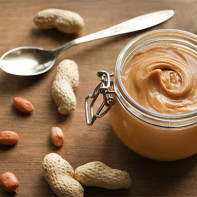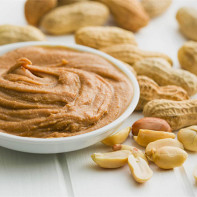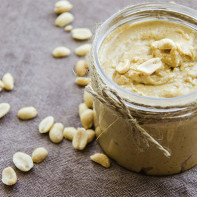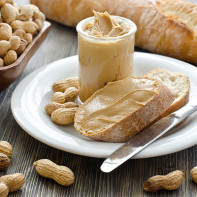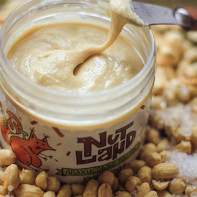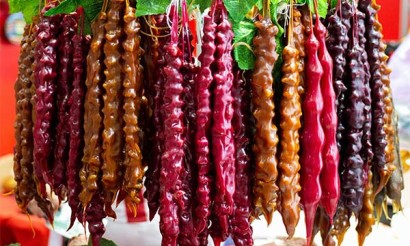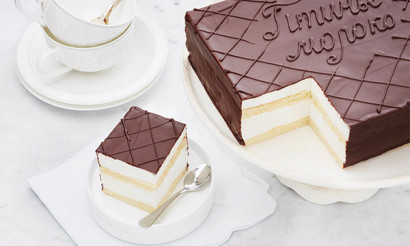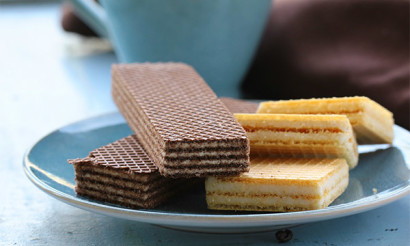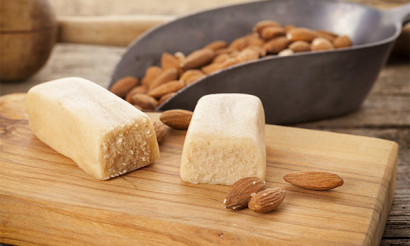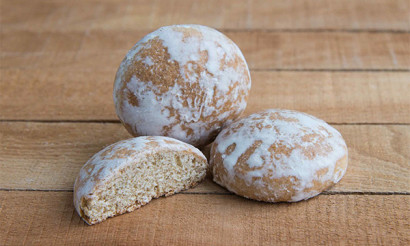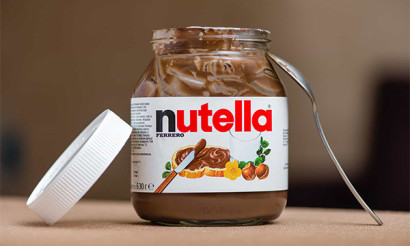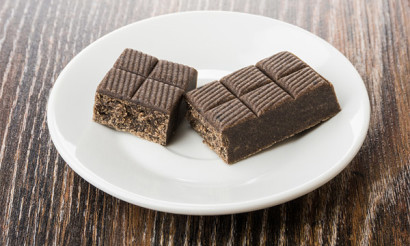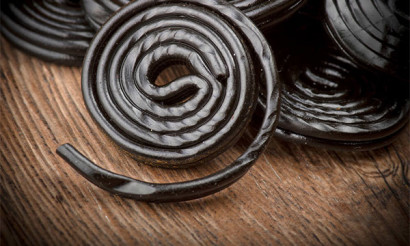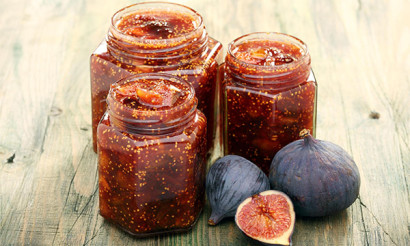Peanut paste: useful properties and contraindications
Peanut paste is a product of the same name roasted, peeled and crushed nuts. The degree of their grinding depends on whether the paste will be creamy homogeneous or with bits of nuts caught in the overall mass.
- What is the difference between peanut butter and paste
- Composition and Calories
- What are the benefits of peanut butter paste
- For Women
- For Men
- Pregnancy
- Breastfeeding
- For Children
- For Athletes
- Is it possible to eat peanut paste when losing weight
- Peanut paste in medicine
- For Diabetes Mellitus
- For pancreatitis
- Gastritis
- For constipation
- Hazards and Contraindications
- Symptoms of Peanut Butter Allergy
- How to Choose and Store Peanut Paste
- How to Make Peanut Paste at Home
- How to Eat Peanut Paste
- How much can I Eat in a Day
- Can I Eat at Night?
- What to eat peanut butter with
- What You Can Make from Peanut Paste
- Interesting Facts about Peanut
Salt and sugar, stabilizers for a stable consistency, cocoa, candied fruits, etc. are added to the paste.
What is the difference between peanut butter and paste
In everyday life, peanut butter is often called butter because it can be spread on bread like butter. But in fact, they are fundamentally different things. This misconception originates from the English language, where pasta is called the word "butter," just like butter, animal oil. And liquid peanut butter is called by the word that refers to all vegetable oils - "oil".
A paste is a mass of ground peanuts. And oil is the liquid obtained by pressing the peanuts.
Composition and calories
Peanut paste is extremely rich in useful components, vitamins and minerals. This is due to the high saturation of these components of the peanut itself. Its composition includes nicotinic, pantothenic and folic acids, riboflavin, inositol, cholecalciferol, alpha-tocopherol, retinol, as well as calcium, magnesium, manganese, phosphorus, sodium, zinc, potassium, selenium, iron and copper.
Pasta is considered a high-calorie product, because its caloric value per 100 grams varies from 570 kcal to 600 kcal. Fats in the pasta composition - 75%, proteins - 17% and carbohydrates - 8%.
How is peanut butter useful?
Peanut butter, thanks to its rich nutritional composition, is an essential part of a healthy, complete diet. Its regular use helps maintain normal blood cholesterol and sugar levels, prevents the emergence and development of atherosclerosis and diseases of the nervous and cardiovascular systems, ensures normal functioning of the gallbladder and liver, improves the regenerative functions of the latter, strengthens cartilage, bone (including teeth), body and immune system.
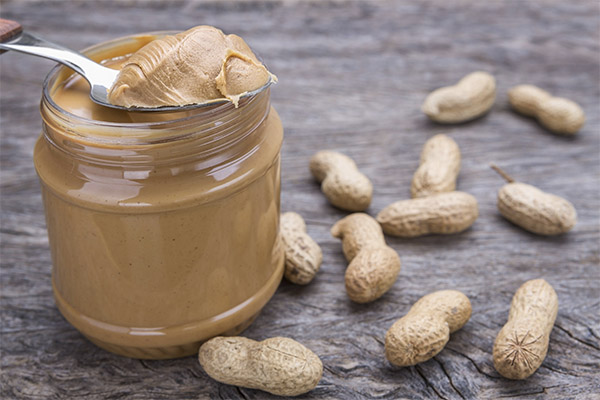
For women
Due to the high content of antioxidants, peanut paste helps women to maintain the beauty and youthfulness, health of the skin, hair and nails. The presence of folic acid in its composition makes it useful for planning pregnancy and during pregnancy. Consumption of peanut paste accelerates the onset of the planned conception and ensures the healthy and proper development of the fetus. The product has a favorable effect on a woman's hormonal background.
For men
Peanut paste increases the level of testosterone in the blood of a man, i.e. increases potency. "Magic" nut mass perfectly fights adenoma and prostatitis, helps in the complex fight against infertility. Regular use of this product prevents the development of many diseases of the genitourinary system.
During pregnancy
During pregnancy, the use of peanuts and peanut products, including peanut paste, is useful as follows:
- Softens the unpleasant manifestations of toxicosis due to the large amount of antioxidants.
- Improves blood vessels and maintains normal hemoglobin levels.
- Thanks to the presence of B vitamins has a positive effect on the emotional state of the pregnant woman, calming the nervous system.
- It helps to fight with dry skin and prevents the excessive appearance of stretch marks.
Breastfeeding
When breastfeeding, peanut paste provides an abundant and stable lactation due to the high protein content. Milk becomes very nutritious, full of useful elements and nourishing. Babies fed with such milk are more nourished and sleep better.
But peanuts - a very strong allergen, so you should be very careful to introduce it into the diet of a woman breastfeeding a newborn baby. The risk of allergic manifestations is reduced if the woman ate pasta during pregnancy. Bloating in the baby may also be observed. In case of any manifestations of allergies or intestinal problems, you should immediately refuse to eat peanut paste.
For kids
A healthy diet, enriched with useful micronutrients, is very important for the growth and development of the child's body. A child's diet is different from an adult's diet, children need more nutrients.
Peanut butter, as mentioned above, is very rich in vitamins and micronutrients, so it is essential in children's diets. In addition, it gives a feeling of fullness and satiety for a long time, which is very important for an energetic and active daily routine.
Nut paste contains a lot of iron, magnesium, zinc, folic acid, which are essential for children's bodies. Iron is good for blood composition, magnesium normalizes blood pressure and is responsible for metabolism, zinc strengthens the immune system and folic acid renews cells.
For athletes
For people who are into sports, peanut butter is an indispensable part of the diet. It is a rich source of protein highly valued by athletes because it helps them build muscle mass quickly and effectively.
When used in small quantities, peanut butter gives satiety and energy for a long time without causing an increase in subcutaneous fatty deposits or distension of the stomach.
Numerous experiments have proven a direct correlation between muscle definition and testosterone levels in the blood. Peanut paste increases the content of this hormone, which allows you to achieve muscle definition more quickly, as well as strengthen the skeleton and maintain a good mood.
Choline normalizes the nervous system in stressful and difficult situations that regularly arise from strenuous training and competition. It also supports the liver, which suffers from intermittent use of fat burners and protein supplements.
Can I Eat Peanut Paste When Losing Weight
The answer to the question of whether you can eat peanut butter paste while losing weight is ambiguous. On the one hand, it gives a prolonged feeling of satiety and keeps muscles toned, on the other hand, it is very caloric.
When losing weight, you should limit your intake of peanut paste to four teaspoons a day. It is better eaten with bread or crackers, with fresh fruit or berries. Since it is rich in fat, the meat for the period of this diet should be lean: poultry, veal, rabbit. It is better to cook steamed dishes.
The effectiveness of such a peanut diet is not proven, so you need to carefully weigh all the pros and cons before starting it. And it is better in this case to choose the most natural paste (preferably prepared by yourself) and with a minimum amount of additives.
Peanut paste in medicine
Due to the high content of useful components, peanut paste has found its application in the complex fight against some diseases.
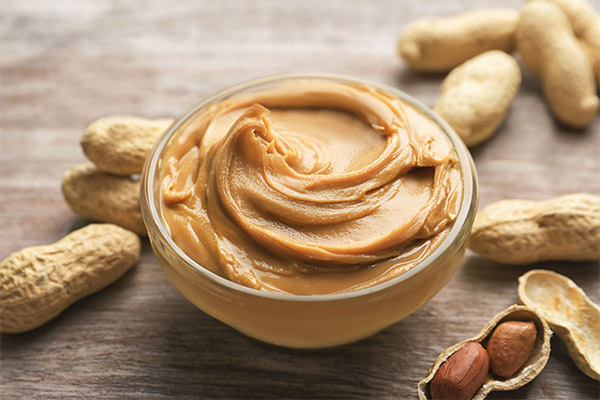
In case of diabetes mellitus.
People with diabetes should choose their food based on its glycemic index. It indicates how much the blood sugar level will increase after they are eaten. People with type 2 diabetes can only eat foods with an index less than 50. But diabetics need to watch the caloric content of food, because you need to control your weight. Products with an index of zero, but very fat, are contraindicated. They do not raise sugar levels, but they can cause cholesterol clogging of blood vessels. Peanuts have a glycemic index of 15. The proteins and fats from this nut are much faster and easier to digest than the same proteins and fats from meat or fish.
Diabetics can eat many kinds of nuts, including peanuts and peanut products, hence peanut paste. But because of the high caloric content, you need to limit the consumption of 50 g per day.
Conclusion: vitamins from peanut paste are necessary for the body of a person suffering from diabetes, but in strictly controlled amounts.
In pancreatitis
In acute pancreatitis, the patient's diet is strictly regulated by the attending doctor. The patient can eat little, fats are excluded. When symptoms subside, it is allowed to loosen his diet a little, expand his diet a little, but not so much as to include nuts in the diet. The food should be protein. Consumption of peanut paste can lead to a recurrence of the disease.
In chronic pancreatitis, peanut paste can be eaten during periods of remission and only in very small amounts. After the first use, you need to listen carefully to your body, whether there were any consequences after such a meal. If everything is okay, then you can gradually introduce it into the diet.
Observing the recommendations and instructions of the doctor, you can avoid the aggravation of pancreatitis and deterioration of the condition and get the maximum of its benefits for the body from peanuts.
For gastritis
On the one hand, peanuts are very useful, but on the other hand they are hard to digest. And during gastritis the stomach is weakened. So is it possible to eat peanut paste with this disease? Dietitians do not classify peanuts as either forbidden or allowed products with gastritis.
Recommendations for gastritis with reduced and increased acidity are different. Peanuts take an active part in the processes of fermentation, which leads to a strong acidification of the environment of the stomach. Therefore, the use of peanut paste in gastritis with hyperacidity is excluded.
With gastritis with reduced acidity, enzymes are secreted in insufficient quantities, and motility is slowed. For these reasons, you need to consume peanut products: it improves the mechanical breakdown of food and increases muscle contractility. Since peanuts must be roasted, peeled and crushed before consumption, peanut paste is the best choice for this purpose.
But, of course, before consuming such a complex and ambiguous product, it is necessary to consult a doctor.
For constipation.
Peanut paste contains vegetable fibers. Albeit not in the largest amount, but nevertheless it contains them. And this means that it will improve bowel function and its motility, contribute to the normalization of stools, prevent constipation or alleviate the condition when there is already a problem.
Harms and contraindications
Despite the undeniable benefits of peanut paste, it can also cause harm to the body.
Peanut is a hyperallergenic product. And the allergy to it manifests itself with very serious symptoms and runs very hard. Therefore, any allergic person, before introducing peanut paste into the diet, should be tested for an allergic reaction.
Also, unnecessary additives in the paste are detrimental. It is necessary to pay attention to its composition and give preference to the purest possible products. Palm oil, dyes, soybean oil, preservatives, flavorings are all undesirable additives.
The calorie content and high fat content in peanut butter can also be attributed to such features of the product, which, if consumed in excess, will bring harm to the body.
Contraindications to the use of peanut butter paste:
- Allergies and individual intolerance;
- arthritis;
- gout;
- arthritis;
- Diseases of the gastrointestinal tract in the acute stage;
- acne, acne;
- varicose veins.
In diseases of the joints, peanut paste is contraindicated because of the high protein content, in gout - because of purines that contribute to the deposition of salts, in skin problems - because of oily and dry skin, which will increase inflammation, in varicose veins - because of the styptic properties.
Symptoms of allergy to peanut paste
Allergy symptoms:
- Perspiration and sore throat;
- nausea, vomiting;
- Itching of the skin on the neck and lips;
- swelling of the tongue and lips, feeling of distention;
- swelling of the pharynx and larynx to the point of difficulty in breathing;
- dyspnea, cough, asthmatic attacks;
- anaphylactic shock.
How to choose and store peanut butter
Quality peanut butter paste should have only peanuts and salt in its composition. If the list of components contains rapeseed, soy, palm or cottonseed oil, you should not take such a product. Some manufacturers add sugar or glucose syrup. This is an undesirable additive, but not as bad as hydrogenated oils.
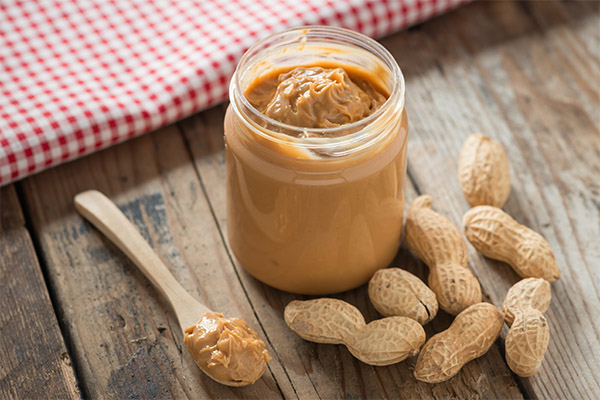
There may be a layer of fat on the surface of the paste - this is normal. You just need to stir the pasta before using it.
The color of a good paste should be distinctly brown, slightly reddish. The flavor should be sweet, but not obtrusively cloying. In the taste, the honey note should not be alarming - this is the norm and a sign of using good nuts to make the pasta.
Particular attention should be paid to pasta that is claimed to be low-fat. It would seem that such a product would be less harmful. But the fat is compensated with sugar and oils, which ends up giving the same calorie content and more harm to the body (compared to natural peanut fat).
Before opening the jar the pasta can be stored at room temperature (in kitchen cabinets or on a shelf), but after opening - only in the refrigerator. The maximum shelf life is 2 months.
How to make peanut butter paste at home
To be 100% sure of the composition of the peanut benefit, it is better to prepare it yourself. There is nothing complicated about it.
Ingredients:
- 500 g of peanuts;
- half a teaspoon of salt;
- 1 tablespoon vegetable oil (sunflower or peanut oil);
- 1 tablespoon honey.
Preparation:
- Raw peanuts should be washed and dried on a towel. Then place them in an even layer on the tray and put in the oven at 180 degrees for 5 minutes. You need to keep an eye on the peanuts, so that they don't burn, because you may have to increase the roasting time to 7-10 minutes.
- Pour the roasted peanuts into a blender and chop. After about two minutes of continuous grinding, the desired consistency of the nut mass is achieved.
- Add salt, honey and oil and mix everything in a blender.
Sometimes the paste seems too thick. You can, of course, leave it like that, but it is worth considering that such a product can even be difficult to chew, despite its creamy state. Therefore, you can safely add water to the paste until you reach the desired thickness. There are no exact proportions: as much as you need and seems necessary, so much can be added.
If desired, you can also add chocolate, cocoa, coffee, nutmeg, cinnamon, etc. to the paste.
It is not recommended to cook this product for a week at the most. Once it runs out, then you can prepare the next portion.
How to Eat Peanut Paste
How much you can eat per day
The daily norm of peanut paste is equal to 4 teaspoons or 2 tablespoons with a slide. It is not worth eating more if you have health problems or do not want to put on extra weight.
Can I Eat at Night
Because of the high calorie content of the product and high fat content, it is not recommended to eat peanut butter in the evening, this is not the best time.
But, if you need to gain weight, you can add a teaspoon of paste to cottage cheese and eat it in the evening. In this way, the body will get both the necessary fats and digest the cottage cheese well.
What you eat peanut butter with
Peanut butter pairs well with many foods.
The safest options for your figure are:
- As a salad dressing (e.g., balsamic vinegar, peanut paste and sesame oil);
- with oatmeal;
- as an additive to sauces on fish and meat for a nutty "note";
- with green apples and bananas;
- as a filling for homemade candies;
- with eggplants (for example, as a filling for eggplant rolls);
- as a component of a smoothie;
- with whole-grain breads or bran bread;
- as a component of homemade cookies;
- with natural jams;
- as a sauce for fresh vegetables;
- as an additive in curries for stewed vegetable dishes.
What you can make with peanut paste
There are many very affordable, simple, healthy and delicious recipes using peanut butter. It is impossible to list them all, but you can pay attention to the most popular ones.
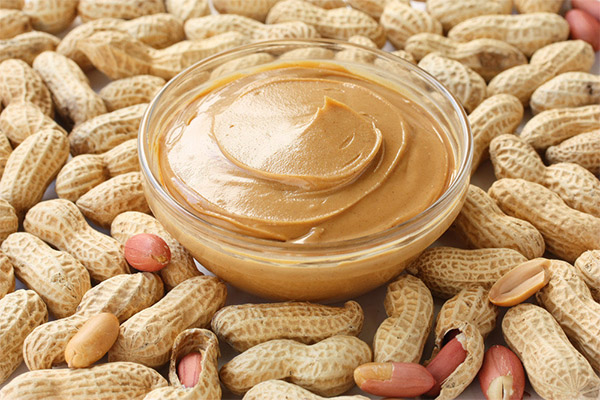
- You can simply boil oatmeal with peanut paste. This will be a wonderful tasty and nutritious breakfast. Boil ordinary oatmeal in water. For the so-called liquid "smeared" you need to take twice as much water as cereal, for thick porridge - 1:1. In the finished porridge for each portion already in the plate simply add a teaspoon of peanut paste. Pasta goes great with fresh fruits and berries, so you can additionally add apple slices, banana rings, a few berries (cherries, strawberries, blueberries), etc.
- With pasta you can prepare not only breakfasts and snacks, but also full meals, such as a salad. The most popular is a salad with peanut paste called "Chinese Miracle". Greens (any - to taste) serve as the base. You can take regular lettuce, Peking cabbage, lettuce leaves and arugula. Dice as much as possible (just square slices). Slice tomatoes (preferably small, like cherry tomatoes). Shred the dill. Place it all in a dish without mixing, in the order of cutting: first the cabbage, then the tomatoes, then sprinkle with dill. In the middle of the salad put a portion of the sauce, which is prepared as follows. Two tablespoons of peanut paste mixed with a teaspoon of freshly squeezed lemon juice and a pinch of salt. Stir it all together thoroughly. On top of the salad and sauce, you can additionally pour some whole peanuts.
- Peanut paste is a sweet dish. Therefore, you can't do without a recipe for a dessert made of it. In a blender, you need to load one bar of tofu, 4 teaspoons of peanut paste and 1 teaspoon of powdered sugar. You can take the paste with the addition of chocolate or add it separately with the other components in the blender. Whisk the mixture until you obtain a smooth, delicate and fluffy mousse. Place it in creams and decorate as you like: chocolate or coconut, nuts, berries, powdered sugar, etc. This dessert is very sweet, so it goes well with green or weak black tea without added sugar.
- Another variation of the pasta sandwich implies a rather hearty and dense snack - it is a clab sandwich with peanut butter. Cut the bread "brick" diagonally to make slices, familiar to the classic sandwich. Spread a thin layer of peanut butter on the bread, then place the banana rings, sprinkle with raisins and cover with another slice of bread smeared with the butter. Such sandwiches toast on a griddle without adding vegetable oil until they form a crispy crust.
- Peanut paste makes excellent sauces for a variety of dishes. It gives them a unique delicate nutty flavor. For example, a great option is a stew with this kind of sauce. 4 medium onions finely chop and fry in vegetable (preferably coconut) oil until golden. Then add the spices (pepper, turmeric, cumin) and fry for another half a minute to a minute until the persistent aroma of spices. Peel 800-900 grams of tomatoes, cut into small cubes and place in the pan with the onions. Add 1 tablespoon of coconut oil and 2 pieces of peeled and diced yams. Put the lid on and simmer until the yams are cooked. When it is ready, add the peanut butter (1 tablespoon), 2 tablespoons lime juice, 2 tablespoons soy sauce, salt to taste and fresh spinach (about 100g). Simmer a little longer until the spinach leaves are wilted. The dish is ready. Serve with peanuts and coriander leaves.
- What about the "unhealthy" foods? For example, fried foods. Those who, due to health conditions sometimes allow themselves a fried dish, can take note of the following recipe for fritters. In a blender, mix 50 g of oatmeal, 100 g of bananas, 100 g of apples, 150 ml of milk and 2 tablespoons of peanut paste. Fry the fritters in a pan in vegetable oil, just like the usual flour fritters. It is better to cook them in olive oil. Serve very tasty with sour cream or berry jam. To make this dish, it is better to use unsweetened pasta, because otherwise it gets really stodgy. You can dilute the sweetness with a sour apple or instead of jam take fresh berries without sugar.
It is worth noting that such an ingredient as peanut butter is excellent for consumption during Lent. It is a completely plant-based product, very healthy and brings variety to a boring and unleavened diet.
Interesting facts about peanuts
Curious facts about peanuts and peanut products:

- The peanut is actually a bean. Its fruits are arranged in pods that "burrow" into the ground as they ripen.
- The name "peanut" itself comes from the ancient Greek word for "spider," most likely because of the resemblance of the pattern to a spider's web.
- It should take at least 5 months from planting before the peanut matures and is harvested.
- In the United States, peanuts are among the ingredients needed to make explosives. In Russia, soybeans are used instead.
- There is even a monument to peanuts in the United States.
- Any products containing peanuts are prohibited when traveling by airplane. The reason for this is the high allergenicity of this nut, which can cause severe attacks of suffocation and even death.
- Peanut protein is used to make ardyl (vegetable wool), plastic, and glue.
- March is called peanut month in America because it is the time of the harvest. America grows an enormous amount of this groundnut, most of which is used to make peanut butter.
- The average American eats about 3 kg of peanut pasta a year.
- In 1904 at the Universal Exposition, the pasta made from this nut received the title of "new pleasure".
- Peanuts are much loved in America. 75% of all families eat peanut paste daily for breakfast.
- About 30 tons of peanuts are harvested worldwide each year. The biggest producers are America, China and India.
- The cake that remains after pressing the peanut oil is used to feed livestock.
- The husks of peanuts have also found a useful application: it is used to improve the quality of the soil, it makes packaging and insulation material, it is used as bedding for birds on farms. It also makes a great filler for cat litter and material for lighting a fire in a fireplace.
- Peanut oil accelerates tissue regeneration and promotes rapid wound healing.
- The Guinness Book of Records records the toss of a peanut fruit 34 meters.
- Thomas Jefferson and Jimmy Carter, American presidents, were both peanut farmers before their political careers.
- There is an artificial peanut island in Florida.
- The idea of turning peanuts into paste dates back to the ancient Aztecs.
- Arachibutyrophobia is the fear that peanut paste will stick to the palate and cause death by suffocation.
- Peanuts are native to South America.
- Alan Shepard, the first American to go into space, took peanuts with him to the moon - so the fruit visited the moon in 1971.
- In ancient times, if people did not like the performance of artists, they pelted them with peanuts.
- March 15 is National Peanut Day in America.
- November is Peanut Butter Lovers Month in America.
- Roasted peanuts are healthier than raw peanuts: the amount of antioxidants in them increases by a quarter.
- Peanuts are very fond of mice, so they can be used as bait in various traps.
- One peanut contains 1 to 5 kernels.
- In reality, only 0.6% of people are allergic to peanuts.
- Peanuts contain no cholesterol at all.
- Peanut oil is a favorite oil of submariners. They prefer to cook with it because it does not stink even at high temperatures.
- Another record is Tom Miller pushing a peanut with his nose up the mountain peak of Pike. Its height is more than 4 km. It took him almost 5 days.
- African residents unusually use peanuts in national dishes: they cook soup and porridge with the addition of millet.
«Important: all the information on this site is provided solely for introductory For educational purposes only. Consult with a health care professional before using any recommendations. specialist before using any of the recommendations. Neither the editors nor the authors shall be held liable for any possible harm caused by materials."

